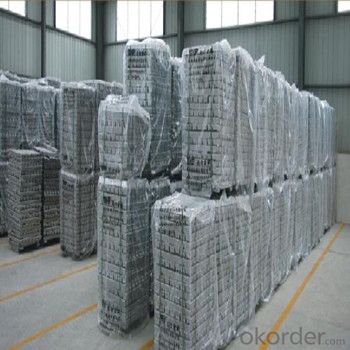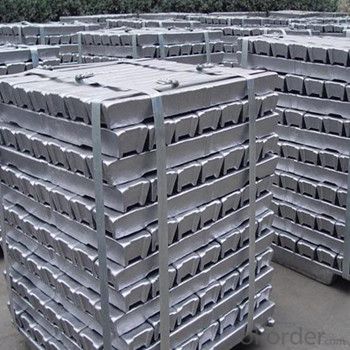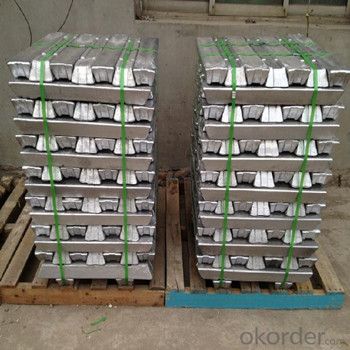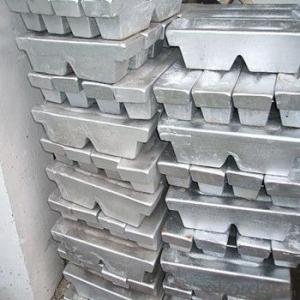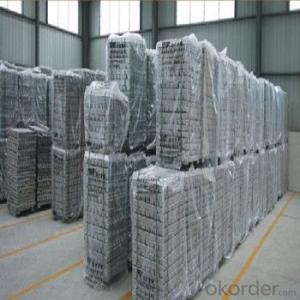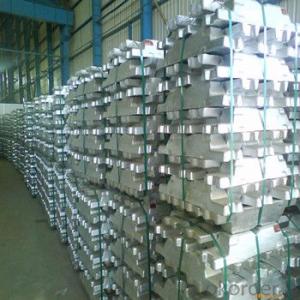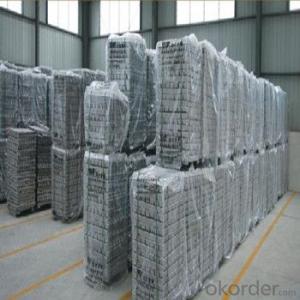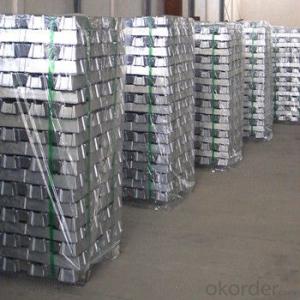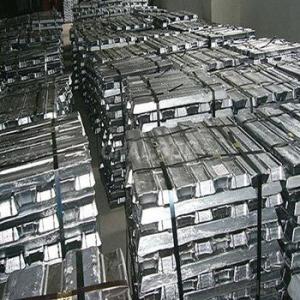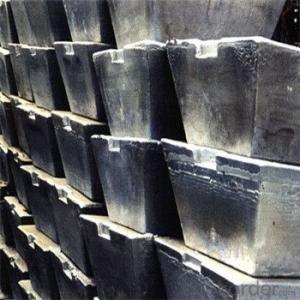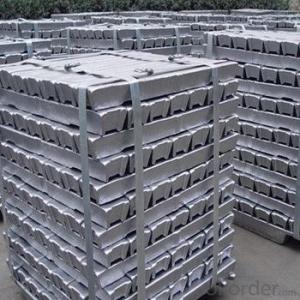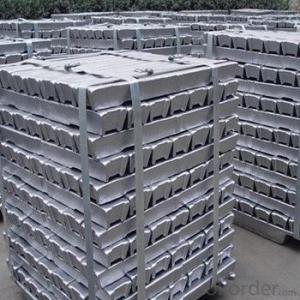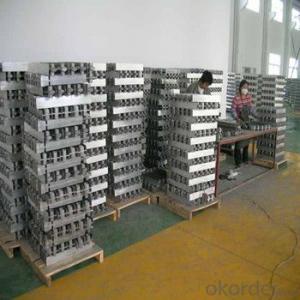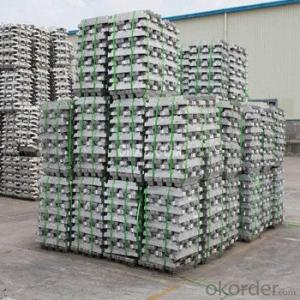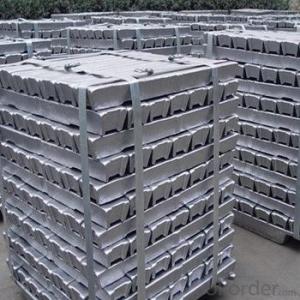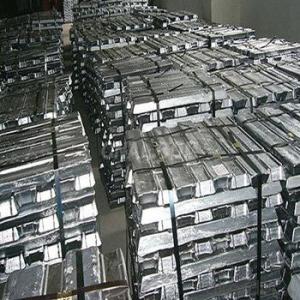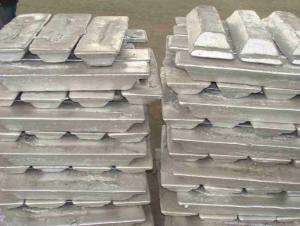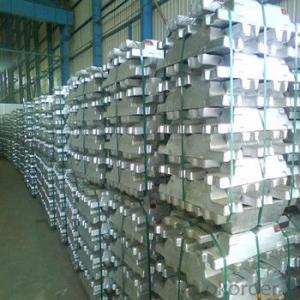Aluminum Pig/Ingot With 99.9% Putity For Selling
- Loading Port:
- China main port
- Payment Terms:
- TT OR LC
- Min Order Qty:
- 1000 m.t.
- Supply Capability:
- 100000 m.t./month
OKorder Service Pledge
OKorder Financial Service
You Might Also Like
Pure Aluminum Pig/Ingot Used for Industry
1.Structure of Aluminum Pig/Ingot
A material that has been cast into a shape in order to be transported and processed easier than in an unprocessed form. An ingot is typically rectangular in shape, which allows it to be stacked. Ingots are most commonly associated with metals, with ingots of gold held in the vaults of banks and brokerages being popular images.
Aluminum Ingot is with the AL as the main chemical composition.Aluminum Ingot is used for industry,such as automobile,pinning and weaving,electron broadly and so on. Aluminum Ingot has the following advantages: easy control and operation, fast melting.
2.Main Features of the Aluminum Pig/Ingot
•High Purity
•Easy control and operation
•High strength
•Fast melting
•Competitive price
•Best Service
3.Aluminum Pig/Ingot Images
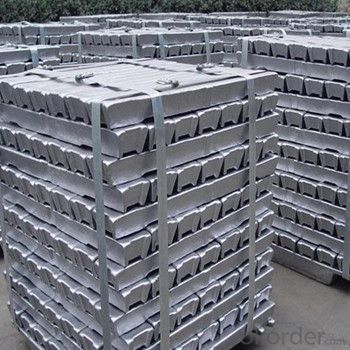
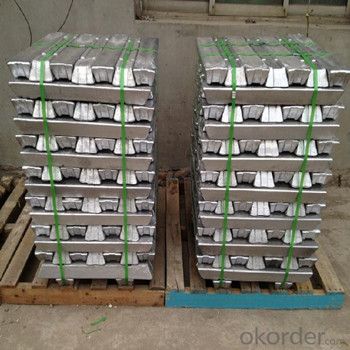
4.Aluminum Pig/Ingot Specification
Grade | Chemical Composition % | |||||||||
Al≥ | impurities ≤ | |||||||||
Si | Fe | Cu | Ga | Mg | Zn | Mn | others | Sum | ||
Al99.9 | 99.90 | 0.50 | 0.07 | 0.005 | 0.02 | 0.01 | 0.025 | - | 0.010 | 0.10 |
Al99.85 | 99.85 | 0.80 | 0.12 | 0.005 | 0.03 | 0.02 | 0.030 | - | 0.015 | 0.15 |
Al99.7 | 99.70 | 0.10 | 0.20 | 0.010 | 0.03 | 0.02 | 0.030 | - | 0.030 | 0.30 |
Al99.6 | 99.60 | 0.16 | 0.25 | 0.010 | 0.03 | 0.03 | 0.030 | - | 0.030 | 0.40 |
Al99.5 | 99.50 | 0.22 | 0.30 | 0.020 | 0.03 | 0.05 | 0.050 | - | 0.030 | 0.50 |
Al99.00 | 99.00 | 0.42 | 0.50 | 0.020 | 0.03 | 0.05 | 0.050 | - | 0.050 | 1.00 |
5.FAQ of Aluminum Pig/Ingot
We have organized several common questions for our clients,may help you sincerely:
①How about your company?
A professional factory which foucs on producing the aluminum pig,can meet customers' requiement to the quality and grade.The quality also have been accepted by customer.Already got the good reputation among the customers.It have gotten lot of much experience.The facrtory has the professional Technical Worker and the advanced equipments for production.Beside,it has the profesional teams to operate the whole proess for exporting.OEM service is availble and welcome.The items have beedn exported around the world,and have been acceptable among the customers,and have gotten the good reputation already.No matter from the quality,price and service,can be guaranteed for the cusgtomers.High purity and diffent grade are available.
②How to guarantee the quality of the products?
We have established the international advanced quality management system,every link from raw material to final product we have strict quality test;We resolutely put an end to unqualified products flowing into the market. At the same time, we will provide necessary follow-up service assurance.
③How long can we receive the prod rking days, We will arrange the factory delivery as soon as possible. The pecific time of receiving is related to the state and position of customers.Commonly 7 to 10 working days can be served.
- Q: What are the different welding methods for aluminum ingots?
- Aluminum ingots can be welded using various methods, each offering unique advantages and applications. Some commonly used welding methods for aluminum ingots include: 1. TIG Welding: TIG welding is a popular option for welding aluminum ingots. It utilizes a non-consumable tungsten electrode to create an arc and a shielding gas to protect the weld from atmospheric contamination. TIG welding provides precise and high-quality welds with excellent heat control. It is commonly used in industries like aerospace and automotive, where top-notch welds are essential. 2. MIG Welding: MIG welding is another widely employed method for aluminum ingots. It involves using a consumable wire electrode and a shielding gas to safeguard the weld zone. MIG welding is relatively quicker and easier to learn compared to TIG welding, making it suitable for applications that require high productivity and volume, such as fabrication and manufacturing. However, it may not offer the same level of precision as TIG welding. 3. GMAW: GMAW, also known as MIG welding, is commonly utilized for aluminum ingots. It employs a continuous wire electrode and a shielding gas to protect the weld from atmospheric contamination. GMAW offers high welding speeds and finds extensive use in industries like automotive and construction, where efficiency and productivity are crucial. 4. PAW: PAW is a versatile and precise welding method that can also be used for aluminum ingots. It utilizes a focused plasma arc and a shielding gas for protection. PAW can produce high-quality welds with minimal heat input, making it suitable for thin aluminum sheets or delicate applications. 5. FSW: FSW is a solid-state welding process suitable for aluminum ingots. It involves using a rotating tool to generate friction and heat, which softens the material and enables joining. FSW is particularly beneficial for joining thick or complex aluminum structures, as it reduces the risk of distortion and produces strong, defect-free welds. In summary, the choice of welding method for aluminum ingots depends on factors such as desired weld quality, productivity requirements, material thickness, and specific application. Each method has its own advantages and limitations, and it is crucial to select the most appropriate method based on the specific project requirements.
- Q: How are aluminum ingots used in the production of electrical enclosures?
- Aluminum ingots are used in the production of electrical enclosures as they are melted down and cast into specific shapes and sizes to create the main body of the enclosure. The ingots provide the necessary raw material for the enclosure's construction, offering strength, durability, and corrosion resistance. Additionally, aluminum ingots can be easily formed, machined, and welded, allowing for the creation of intricate designs and precise dimensions required for electrical enclosures.
- Q: What are the advantages of using aluminum ingots in the production of electrical transmission lines?
- Using aluminum ingots in the production of electrical transmission lines offers several benefits. Firstly, aluminum, being a lightweight metal, is easier to transport and install compared to materials like copper, reducing overall costs and effort involved in construction and maintenance. Secondly, aluminum possesses excellent conductivity properties, enabling efficient transmission of electricity. This results in less energy loss during transmission, increasing efficiency and minimizing power wastage. Furthermore, aluminum exhibits high resistance to corrosion, making it ideal for outdoor applications. It can withstand harsh weather conditions and environmental factors, ensuring the longevity and reliability of transmission lines. Additionally, aluminum is a cost-effective option due to its abundance and relatively low extraction cost. This affordability makes it a suitable choice for large-scale transmission line projects. Moreover, aluminum is highly recyclable, making it environmentally friendly. The recycling process requires significantly less energy compared to the production of virgin aluminum, reducing carbon emissions and energy consumption. Lastly, aluminum ingots can be easily shaped into various forms, allowing for flexibility in transmission line design and construction. This adaptability ensures optimal functionality in different terrains and installation requirements. In conclusion, the advantages of using aluminum ingots in electrical transmission line production include lightweight construction, high conductivity, corrosion resistance, cost-effectiveness, recyclability, and design flexibility. These benefits make aluminum a preferred choice for efficient and sustainable electricity transmission.
- Q: How do aluminum ingots contribute to the overall aluminum industry?
- Aluminum ingots play a crucial role in the overall aluminum industry as they serve as the primary raw material for the production of various aluminum products. These ingots are melted down and cast into different shapes, allowing manufacturers to create a wide range of aluminum-based products used in various industries, such as construction, automotive, aerospace, packaging, and electronics. Thus, aluminum ingots are vital for sustaining the growth and development of the aluminum industry by providing the necessary material for the manufacturing of diverse aluminum products.
- Q: Can aluminum ingots be customized for specific applications?
- Yes, aluminum ingots can be customized for specific applications. Aluminum is a versatile material that can be alloyed with other elements to enhance its properties such as strength, corrosion resistance, and thermal conductivity. By carefully selecting the alloy composition and processing techniques, aluminum ingots can be tailored to meet the specific requirements of various applications ranging from automotive parts to aerospace components.
- Q: How about aluminium material?
- Connaught scale is still OK, belong to cutting-edge, old trees send new shoots, they are from the aluminum out, the bird's nest is responsible for aluminum
- Q: What is the role of aluminum ingots in the production of cans?
- Aluminum ingots are a crucial raw material in the production of cans. These ingots are melted down and shaped into thin sheets, which are then used to make the body and lid of the cans. Aluminum is favored for can production due to its lightweight, high strength, and excellent corrosion resistance properties. The ingots are transformed into cans through a series of processes including rolling, cutting, and shaping. Overall, aluminum ingots play a vital role in ensuring the durability, functionality, and sustainability of cans for various industries like food and beverage packaging.
- Q: What is the role of aluminum ingots in the production of aircraft?
- Aircraft production heavily relies on aluminum ingots because of their unique properties and characteristics. In essence, aluminum ingots, which are blocks or bars of pure aluminum, serve as the primary raw material for making various components and structures in aircraft. The outstanding strength-to-weight ratio of aluminum ingots is one of the main reasons why they are preferred in aircraft production. Aluminum is a lightweight metal, making it perfect for aerospace applications where reducing weight is crucial for fuel efficiency and overall performance. By using aluminum ingots, manufacturers can create lightweight parts that contribute to reducing the overall weight of an aircraft. This leads to improved fuel economy and increased payload capacity. In addition, aluminum ingots possess remarkable corrosion resistance, even in harsh environments. This property is particularly important for aircraft as they are exposed to different atmospheric conditions, including moisture, salt, and pollutants. Aluminum's corrosion resistance helps ensure the durability and longevity of aircraft components, leading to reduced maintenance costs and enhanced safety. Furthermore, aluminum ingots are highly malleable and easily shaped, allowing manufacturers to form them into desired aircraft components through various manufacturing processes such as forging, extrusion, and machining. This versatility enables the production of complex parts, such as fuselage panels, wings, and landing gear, with precision and efficiency. Aside from their mechanical properties, aluminum ingots also exhibit excellent thermal conductivity. This characteristic is valuable in aircraft applications as it helps dissipate heat generated by engines, electronic systems, and other components. By efficiently transferring heat away from critical areas, aluminum contributes to the overall thermal management of an aircraft, enhancing performance and preventing overheating. In conclusion, aluminum ingots are essential in aircraft production due to their lightweight nature, corrosion resistance, malleability, and thermal conductivity. These properties enable the manufacturing of strong, durable, and efficient aircraft structures and components, which ultimately contribute to the safety, performance, and reliability of modern aircraft.
- Q: What aluminum factories are there in Guangdong and Foshan?
- I suggest to use tide abundant aluminium material, electrophoresis material price is in same grade calculate cheap, aluminous ingot valence adds electrophoresis to process cost 4900-5000 yuan, every tons or so.
- Q: How are aluminum ingots used in the production of aerospace components?
- Aluminum ingots play a crucial role in the production of aerospace components due to their unique properties and characteristics. These ingots are melted down and refined to create high-quality aluminum alloys that are specifically designed to meet the demanding requirements of the aerospace industry. One of the main reasons aluminum is widely used in aerospace manufacturing is its low density. Aluminum is a lightweight material, which helps reduce the overall weight of the aircraft, resulting in improved fuel efficiency and increased payload capacity. This is particularly crucial in the aerospace industry, where every kilogram saved translates into significant cost savings and operational advantages. Another key advantage of aluminum ingots is their excellent strength-to-weight ratio. By alloying aluminum with other elements such as copper, magnesium, or zinc, aerospace engineers can create alloys that possess exceptional strength and structural integrity while maintaining a low weight. These alloys are then used to manufacture various components, such as airframes, wings, fuselage sections, and structural supports, which need to withstand extreme conditions and stresses during flight. Furthermore, aluminum ingots offer exceptional corrosion resistance, making them ideal for aerospace applications. Aircraft are subjected to harsh environments, including exposure to moisture, saltwater, and temperature fluctuations. Aluminum alloys, derived from these ingots, possess a natural oxide layer that provides a protective barrier against corrosion, ensuring the longevity and durability of the aerospace components. Additionally, aluminum ingots can be easily cast, machined, and formed into intricate shapes and designs, allowing for the production of complex aerospace components with high precision. This versatility is essential in the aerospace industry, where intricate and custom parts are required to meet the specific needs and requirements of different aircraft models. In summary, aluminum ingots are essential in the production of aerospace components due to their lightweight nature, excellent strength-to-weight ratio, corrosion resistance, and versatility in manufacturing processes. By utilizing aluminum ingots and their derived alloys, aerospace manufacturers can achieve the perfect balance between performance, durability, and efficiency in their aircraft, contributing to the advancement and safety of the aerospace industry.
Send your message to us
Aluminum Pig/Ingot With 99.9% Putity For Selling
- Loading Port:
- China main port
- Payment Terms:
- TT OR LC
- Min Order Qty:
- 1000 m.t.
- Supply Capability:
- 100000 m.t./month
OKorder Service Pledge
OKorder Financial Service
Similar products
Hot products
Hot Searches



